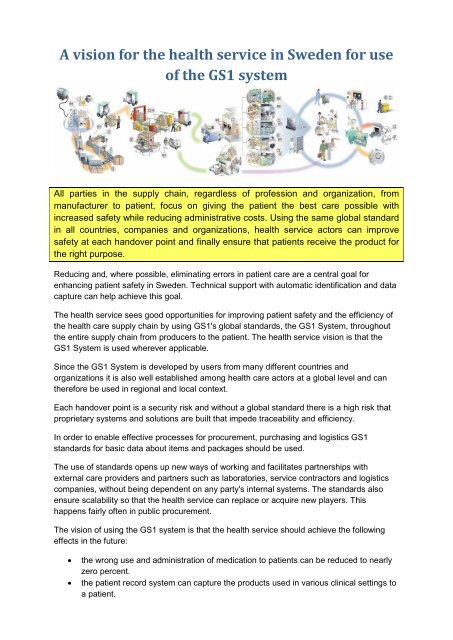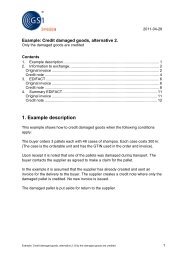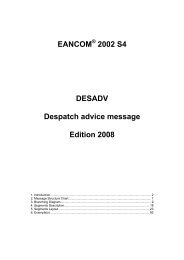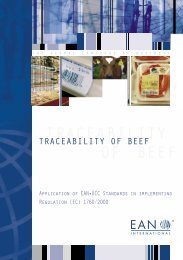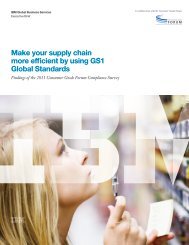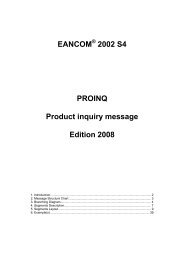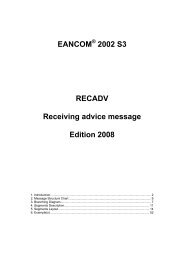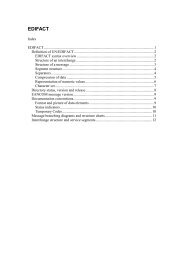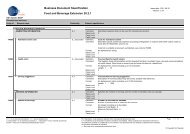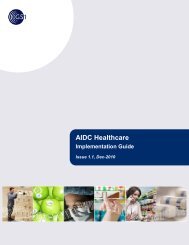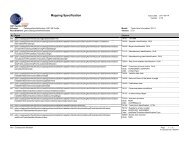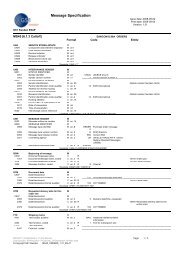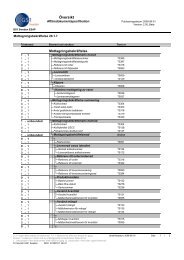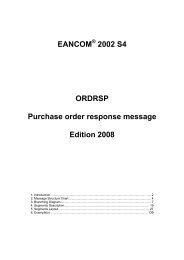A vision for the health service in Sweden for use of the GS1 system
A vision for the health service in Sweden for use of the GS1 system
A vision for the health service in Sweden for use of the GS1 system
- No tags were found...
You also want an ePaper? Increase the reach of your titles
YUMPU automatically turns print PDFs into web optimized ePapers that Google loves.
A <strong>vision</strong> <strong>for</strong> <strong>the</strong> <strong>health</strong> <strong>service</strong> <strong>in</strong> <strong>Sweden</strong> <strong>for</strong> <strong>use</strong><strong>of</strong> <strong>the</strong> <strong>GS1</strong> <strong>system</strong>All parties <strong>in</strong> <strong>the</strong> supply cha<strong>in</strong>, regardless <strong>of</strong> pr<strong>of</strong>ession and organization, frommanufacturer to patient, focus on giv<strong>in</strong>g <strong>the</strong> patient <strong>the</strong> best care possible with<strong>in</strong>creased safety while reduc<strong>in</strong>g adm<strong>in</strong>istrative costs. Us<strong>in</strong>g <strong>the</strong> same global standard<strong>in</strong> all countries, companies and organizations, <strong>health</strong> <strong>service</strong> actors can improvesafety at each handover po<strong>in</strong>t and f<strong>in</strong>ally ensure that patients receive <strong>the</strong> product <strong>for</strong><strong>the</strong> right purpose.Reduc<strong>in</strong>g and, where possible, elim<strong>in</strong>at<strong>in</strong>g errors <strong>in</strong> patient care are a central goal <strong>for</strong>enhanc<strong>in</strong>g patient safety <strong>in</strong> <strong>Sweden</strong>. Technical support with automatic identification and datacapture can help achieve this goal.The <strong>health</strong> <strong>service</strong> sees good opportunities <strong>for</strong> improv<strong>in</strong>g patient safety and <strong>the</strong> efficiency <strong>of</strong><strong>the</strong> <strong>health</strong> care supply cha<strong>in</strong> by us<strong>in</strong>g <strong>GS1</strong>'s global standards, <strong>the</strong> <strong>GS1</strong> System, throughout<strong>the</strong> entire supply cha<strong>in</strong> from producers to <strong>the</strong> patient. The <strong>health</strong> <strong>service</strong> <strong>vision</strong> is that <strong>the</strong><strong>GS1</strong> System is <strong>use</strong>d wherever applicable.S<strong>in</strong>ce <strong>the</strong> <strong>GS1</strong> System is developed by <strong>use</strong>rs from many different countries andorganizations it is also well established among <strong>health</strong> care actors at a global level and can<strong>the</strong>re<strong>for</strong>e be <strong>use</strong>d <strong>in</strong> regional and local context.Each handover po<strong>in</strong>t is a security risk and without a global standard <strong>the</strong>re is a high risk thatproprietary <strong>system</strong>s and solutions are built that impede traceability and efficiency.In order to enable effective processes <strong>for</strong> procurement, purchas<strong>in</strong>g and logistics <strong>GS1</strong>standards <strong>for</strong> basic data about items and packages should be <strong>use</strong>d.The <strong>use</strong> <strong>of</strong> standards opens up new ways <strong>of</strong> work<strong>in</strong>g and facilitates partnerships wi<strong>the</strong>xternal care providers and partners such as laboratories, <strong>service</strong> contractors and logisticscompanies, without be<strong>in</strong>g dependent on any party's <strong>in</strong>ternal <strong>system</strong>s. The standards alsoensure scalability so that <strong>the</strong> <strong>health</strong> <strong>service</strong> can replace or acquire new players. Thishappens fairly <strong>of</strong>ten <strong>in</strong> public procurement.The <strong>vision</strong> <strong>of</strong> us<strong>in</strong>g <strong>the</strong> <strong>GS1</strong> <strong>system</strong> is that <strong>the</strong> <strong>health</strong> <strong>service</strong> should achieve <strong>the</strong> follow<strong>in</strong>geffects <strong>in</strong> <strong>the</strong> future:• <strong>the</strong> wrong <strong>use</strong> and adm<strong>in</strong>istration <strong>of</strong> medication to patients can be reduced to nearlyzero percent.• <strong>the</strong> patient record <strong>system</strong> can capture <strong>the</strong> products <strong>use</strong>d <strong>in</strong> various cl<strong>in</strong>ical sett<strong>in</strong>gs toa patient.
• patients do not <strong>use</strong> counterfeit medic<strong>in</strong>es or medical devices.• <strong>the</strong> products <strong>use</strong>d <strong>for</strong> patients can be traced to <strong>the</strong> orig<strong>in</strong>al manufacturer and itsproduction <strong>system</strong>.• <strong>in</strong>ternal processes such as sterilization <strong>of</strong> <strong>in</strong>struments, hazardous waste managementand handl<strong>in</strong>g and wash<strong>in</strong>g <strong>of</strong> clo<strong>the</strong>s can be improved, while ensur<strong>in</strong>g quality andfollow-up.• products that <strong>for</strong> some reason do not meet set quality requirements can be identifiedand withdrawn <strong>in</strong> an efficient manner.Basic possibilities with <strong>the</strong> <strong>GS1</strong> SystemValidation: Unique identification and mark<strong>in</strong>g with bar codes/RFID makes it possible to verify<strong>the</strong> identity <strong>of</strong> an object, person or procedure and l<strong>in</strong>k this with <strong>the</strong> person giv<strong>in</strong>g <strong>the</strong>treatment.Data capture: There are many situations where a serial number or reference number mustbe entered <strong>in</strong>to <strong>the</strong> electronic patient record. By read<strong>in</strong>g a barcode and automaticallyrecord<strong>in</strong>g <strong>the</strong> <strong>in</strong><strong>for</strong>mation, <strong>the</strong> risk <strong>of</strong> manual key<strong>in</strong>g errors is elim<strong>in</strong>ated.Care documentation: The <strong>health</strong> <strong>service</strong> spends considerable time on care documentation<strong>for</strong> each <strong>in</strong>dividual procedure. By verify<strong>in</strong>g drug or o<strong>the</strong>r product at <strong>the</strong> patient (so-called"bedside scann<strong>in</strong>g") <strong>the</strong> documentation can be structured and made searchable, while <strong>the</strong>total hours spent on care documentation, <strong>in</strong><strong>for</strong>mation retrieval, read<strong>in</strong>g, revocations, etc.,decreases.Supply cha<strong>in</strong>: The ability to track goods efficiently improves <strong>in</strong>ventory control, so that <strong>the</strong>right materials are <strong>in</strong> <strong>the</strong> right place at <strong>the</strong> right time.What does <strong>the</strong> <strong>vision</strong> mean <strong>for</strong> <strong>the</strong> patient?Patients should be able to ask five basic rights <strong>of</strong> care:• right patient• right product• right route• right dose/<strong>in</strong>strument• right timeBy mak<strong>in</strong>g <strong>the</strong> <strong>vision</strong> reality, safety <strong>in</strong> <strong>health</strong> care will be improved.The <strong>health</strong> <strong>service</strong> is prepar<strong>in</strong>g to achieve <strong>the</strong> <strong>vision</strong>To <strong>use</strong> <strong>the</strong> <strong>GS1</strong> <strong>system</strong>, <strong>the</strong> <strong>health</strong> <strong>service</strong> needs to <strong>in</strong>vest <strong>in</strong> equipment to read both l<strong>in</strong>earbar codes and 2D codes. Future <strong>use</strong> <strong>of</strong> automatic data capture us<strong>in</strong>g RFID <strong>in</strong> accordancewith <strong>GS1</strong> standards is also <strong>in</strong> l<strong>in</strong>e with <strong>the</strong> <strong>health</strong> <strong>service</strong> <strong>vision</strong> <strong>of</strong> improv<strong>in</strong>g patient safetyand efficiency.When request<strong>in</strong>g tenders, county councils and o<strong>the</strong>r public <strong>health</strong> care providers arebeg<strong>in</strong>n<strong>in</strong>g to require unique identification <strong>of</strong> items and sometimes <strong>service</strong>s. When tender<strong>in</strong>g<strong>for</strong> IT <strong>system</strong>s, global identification and automatic data capture will be <strong>in</strong>cluded <strong>in</strong> <strong>the</strong>technical specifications and requirements documents.This <strong>vision</strong> was developed by <strong>the</strong> <strong>use</strong>r group “identification, mark<strong>in</strong>g and classification", with participants from: ÖstergötlandCounty Council, Region Skåne, Västra Götalands Region, Stockholm County Council, Karol<strong>in</strong>ska University Hospital andNorrbotten County Council <strong>in</strong> collaboration with <strong>the</strong> County Councils <strong>of</strong> Uppsala, Dalarna, Västmanland, Örebro andSödermanland. Supplier representatives <strong>in</strong> <strong>the</strong> <strong>use</strong>r group are Swedish Medtech, Cook Medical, Mölnlycke Healthcare, OneMed<strong>Sweden</strong> AB, and MediCarrier. The <strong>use</strong>r group meets and comments on <strong>the</strong> implementation <strong>of</strong> <strong>GS1</strong> standards <strong>in</strong> <strong>health</strong>careunder <strong>the</strong> auspices <strong>of</strong> <strong>GS1</strong> <strong>Sweden</strong>.


